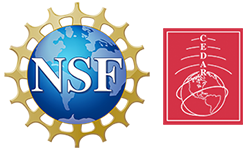2025 Workshop: Impact of Terrestrial Weather on the Space Weather of the ITM
Shantanab Debchoudhury
Larisa Goncharenko
Guiping Liu
Sarah McDonald
Fabrizio Sassi
Jiarong Zhang
Deepali Aggarwal
Bjoern Bergsson
Mack Jones
Zishun Qiao
To enable participation of colleagues who face travel restrictions, there will be a zoom option. https://clemson.zoom.us/j/98138695100
Processes generated by terrestrial weather in the lower atmosphere (i.e., troposphere and stratosphere, altitudes less than ~50 km) are recognized by the scientific community as sources of variability in both the structure and composition of the ionosphere-thermosphere-mesosphere (ITM) region. The ITM is a confluence of energy and processes that interconnect Earth’s atmosphere with space. Exposed to persistent wave forcing from terrestrial weather sources, and solar and magnetic forcing, the ITM is a domain of compelling scientific inquiry that connects thermodynamics, fluid dynamics, electrodynamics and plasma physics. Predicting its mean state and variability, the “space weather” is of significant national interest for space situation awareness including the very low earth orbit (VLEO) as the new frontier of space operations. Advancing the understanding of whole atmosphere interconnections between terrestrial and space weather requires coordinated modeling and observational efforts along with the implementation of new technologies across different spatial and temporal scales. Of particular interest are wave-induced vertical coupling processes that alter the ITM state in multiple ways, including their influence on structure, composition, circulation, and electrodynamics. Recent efforts through NASA’s Living With a Star program and ISSI workshops, to name just a few, clearly show that progress has been made but that significant gaps in our understanding remain. This GC workshop aims to seek the expertise of the broader CEDAR community to help revealing the critical links between weather and space weather through addressing four specific goals.
This is year 2 of the GC workshop.
Zoom: https://clemson.zoom.us/j/98138695100
Session 1
1:30-1:35 Jens Oberheide, Clemson University, Welcome and Introduction
1:35-1:50 Erdal Yiğit, GMU, Observations of Ionospheric and Thermospheric Effects of Hurricanes
1:50-2:05 Jaime Aguilar Guerrero, ERAU, Multi-instrument Imaging of Deep Convective Events and Their Gravity Wave Responses Over CONUS Using AWE, AIRS, TEC, and LLITED Data
2:05-2:20 Hanli Liu, HAO/NCAR, Hanli Liu, HAO/NCAR, Study of Gravity Wave Effects on Dynamics and Transport in the Mesosphere, Thermosphere and Ionosphere Using High-Resolution WACCM-X
2:20-2:35 Josh Pettit, GMU, Preliminary Results from Extending GEOS to the Thermosphere
2:35-2:50 Xian Lu, Clemson University, Quantification of I-T day-to-day variability driven from above and below using TIEGCM, ICON, and COSMIC-2
2:50-3:05 Bjoern Bergsson, ERAU, Advancing Coupled Atmosphere-Ionosphere Simulations: Capabilities and Insights from a Realistic Case Study of AGW-Driven TIDs
3:05-3:20 Federico Gasperini, Orion Space, Impacts of Resolved Gravity Waves on Global-Scale Wave Variability in the Ionosphere-Thermosphere: Insights from WACCM-X, ICON, and COSMIC-2.
3:20-3:30 Discussion
Session 2
4:00-4:15 Nick Pedatella, HAO/NCAR, Planetary wave driven variability in equatorial plasma bubbles
4:15-4:30 Sevag Derghazarian, MIT Haystack, Connections between Stratospheric GWs, the Polar Vortex, and MSTIDs from longitudinally distinct regions
4:30-4:45 Sunil Kumar, Clemson University, Impact of Long-term Arctic Changes on the Mesosphere and Lower Thermosphere
4:45-5:00 Zishun Qiao, HAO/NCAR, Different Characteristics of Interhemispheric Coupling during Early- and Late Winter Major SSWs
5:00-5:15 Jiarong Zhang, Utah State, Impact of Arctic and Antarctic Sudden Stratospheric Warmings on Thermospheric Composition
5:15-5:30 Mukta Neogi, Clemson University, A Quantitative Assessment of Thermospheric Energy and Heating Due to Atmospheric Tides
5:30-5:45 Yen-Jung (Joanne) Wu, UC Berkeley, Tracking the Quasi-6-Day Wave in MLT using ICON/MIGHTI: From Detection to Distinction
5:45-6:00 Yingfei Chen, CU Boulder, TINa SAO and Turning Point Observed by Lidar
The workshop goals are not only at the heart of CEDAR’s coupling and system science spirit but will also help to define more clearly the state-of-the-art in the light of future EZIE, DYNAMIC and GDC missions. Moreover, this workshop will provide an opportunity for NSF/CEDAR ground-based observatories to join forces with a broader community to synergistically enable a transformed view of terrestrial weather-space weather connection.
